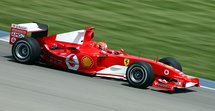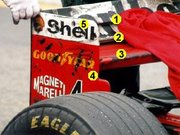Formula One cars
|
|
|
Modern Formula One cars are single-seat, open cockpit, open wheel race cars that have substantial wings at front and rear, and position the engine behind the driver. The regulations governing the cars are unique to the championship. The current Formula One regulations specify that cars must be constructed by the racing teams themselves.
See Formula One regulations for a summary of the current technical and sporting regulations.
| Contents |
Engines
The regulations specify that the cars must be powered by 3.0 litre ten cylinder naturally-aspirated engines in the V10 configuration that have no more than five valves per cylinder. All cars have the engine located between the driver and the rear wheels. The very best engines, widely regarded to be those of the BAR Honda team are believed to be developing over 900 horsepower (670 kW) at 19,000 rpm, and Honda are said to be confident that next year's engine will produce 1,000bhp.
The engines produce over 100,000 BTU per minute (1,758 kW) of heat that must be dumped, usually to the atmosphere via radiators. They consume around 650 litres of air per second. Race fuel consumption rate is normally around 75 litres per 100 kilometers travelled (3.1 mpg).
The engines are a stressed member in most cars. This means that engine is part of the structural support framework, being bolted to the cockpit at the front end, and transmission and rear suspension at the back end.
In the 2004 championship, engines were required to last a full race weekend; in the 2005 championship, they will be required to last two full race weekends and if a team changes an engine, they incur a penalty of 10 grid positions.
Transmission
Formula One cars use semi-automatic sequential gearboxes with six or seven forward gears and one reverse gear. The driver signals gear changes using paddles mounted on the back of the steering wheel and electro-hydraulics perform the actual change as well as throttle control. Clutch control is also performed electro-hydraulically except from and to a standstill when the driver must operate the clutch using a lever mounted on the back of the steering wheel. By regulation the cars use rear wheel drive. A modern F1 Clutch is a multi-plate carbon design with a diameter of less than four inches (102 mm), weighing less than a kilogram and handling 900 horsepower (670 kW) or so.
Aerodynamics
The cars' aerodynamics are designed to provide maximum downforce with a minimum of drag; every part of the bodywork is designed with this aim in mind. Like most open wheeler cars they feature large front and rear aerofoils, but they are more developed than American open wheel racers, which depend more on suspension tuning; for instance, the nose is raised above the center of the front aerofoil, allowing its entire width to provide downforce. They also feature aerodynamic appendages that direct the airflow. F1 regulations prohibit the use of ground effects, so to minimise the downforce provided by ground effects the undertray is flat between the axles and a wooden "plank", measured before and after a race, runs down the middle of the car to prevent the cars from running so low to the ground that they scrape against it. However, a substantial amount of downforce is provided by using a rear diffuser which rises from the undertray at the rear axle to the actual rear of the bodywork. This downforce comes at the cost of what is actually a quite high aerodynamic drag coefficient (about 1 according to Minardi's technical director Gabriele Tredozi [1] (http://www.f1technical.net/feature148.html)), so that, despite the enormous power output of the engines, the top speed of these cars is less than that of World War II vintage Mercedes Benz Silver Arrows racers; however this is more than compensated for by the ability to corner at huge velocity. The aerodynamics are adjusted for each track; with a relatively low drag configuration for tracks where high speed is relatively more important like Autodromo Nazionale Monza, and a high traction configuration for tracks where cornering is more important, like the Österreichring.
Construction
The cars are constructed from composites of carbon fibre and similar ultra-lightweight (and incredibly expensive to manufacture) materials. The minimum weight permissible is 600kg including the driver, fluids and on-board cameras. However, all F1 cars weigh significantly less than this (some as little as 440kg) so teams add ballast to the cars to bring them up to the minimum legal weight. The advantage of using ballast is that it can be placed anywhere in the car to provide ideal weight distribution.
Steering Wheel
2004FerrariWheel.jpg
The driver has the ability to fine tune many elements of the race car from within the machine using the steering wheel. The wheel can be used to alter traction control settings, change gears, apply rev limiter, adjust fuel air mix, change brake pressure and call the radio. Telemetry data such as rpm, laptimes, speed and gear are displayed on an LCD screen. The wheel alone can cost about $40,000, and with carbon fibre construction, weighs in at 1.3 kilograms.
Fuel
The fuel used in F1 cars is fairly similar to ordinary petrol, albeit with a far more tightly controlled mix. Gasoline cannot contain compounds that are not found in commercial gasoline, in contrast to alcohol-based fuels used in American open-wheel racing. Blends are tuned for maximum performance in given weather conditions or different circuits. During the period when teams were limited to a specific volume of fuel during a race, exotic high-density fuel blends were used which were actually heavier than water, since the energy content of a fuel depends on its mass density.
Tyres and brakes
By regulation, the tyres feature a minimum of four grooves in them, with the intention of slowing the cars down (a slick tyre, with no indentations, is best in dry conditions). They must be no wider than 355 mm and 380 mm at the front and rear respectively. Unlike the fuel, the tyres bear only a superficial resemblance to a normal road tyre. Whereas a normal car tyre has a useful life of up to 80,000 km, and even motorcycle tyres are normally good for 15,000 km, in 2005, a tire is built to last just one race distance, which is a little over 300 km. This is result of a drive to maximise the road holding ability, leading to the use of very soft compounds (to ensure that the tyre surface conforms to the road surface as closely as possible).
Performance
F1 cars and the cutting edge technology that constitute them produce an unprecedented combination of outright speed and quickness for the drivers, or pilots. Nearly every F1 car on the grid is capable of going from 0 to 160 km/h (100 MPH) and back to 0 km/h in less than five seconds. During a demonstration at the Silverstone circuit in Britain, a McLaren F1 car driven by David Coulthard gave a pair of Mercedes-Benz street cars a head start of seventy seconds, and was able to beat the cars to the finish line from a standing start.
In an effort to reduce speeds and increase driver safety, the FIA has introduced new rules for F1 constructors. These rules included restrictions on engine computer technology, as well as the introduction of grooved tyres. Yet despite these changes, constructors continue to extract performance gains by increasing power and aerodynamic efficiency. As a result, the pole position speed at many circuits in like weather conditions has dropped between 1.5 and 3 seconds in 2004 over the prior year's times.
External link
F1 Technical (http://www.f1technical.net/)pl:Samochody Formuły 1


